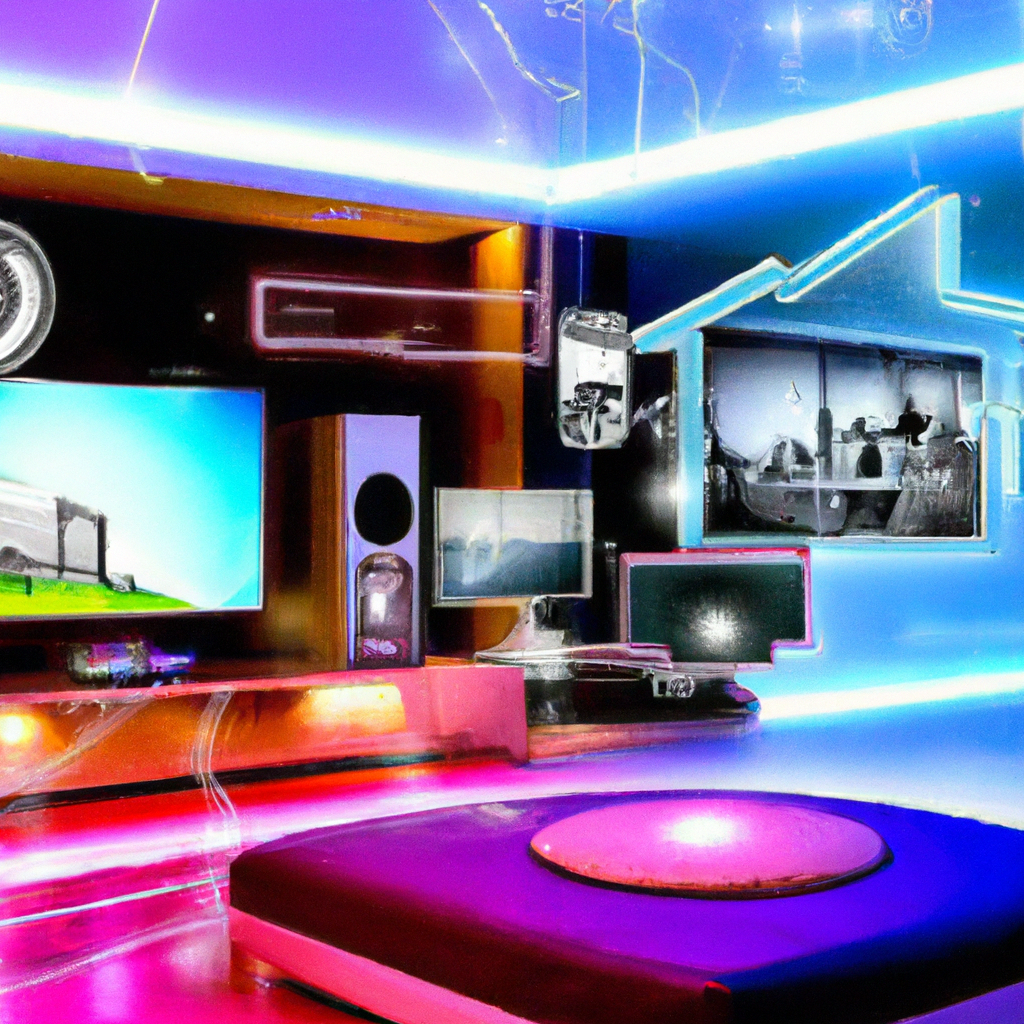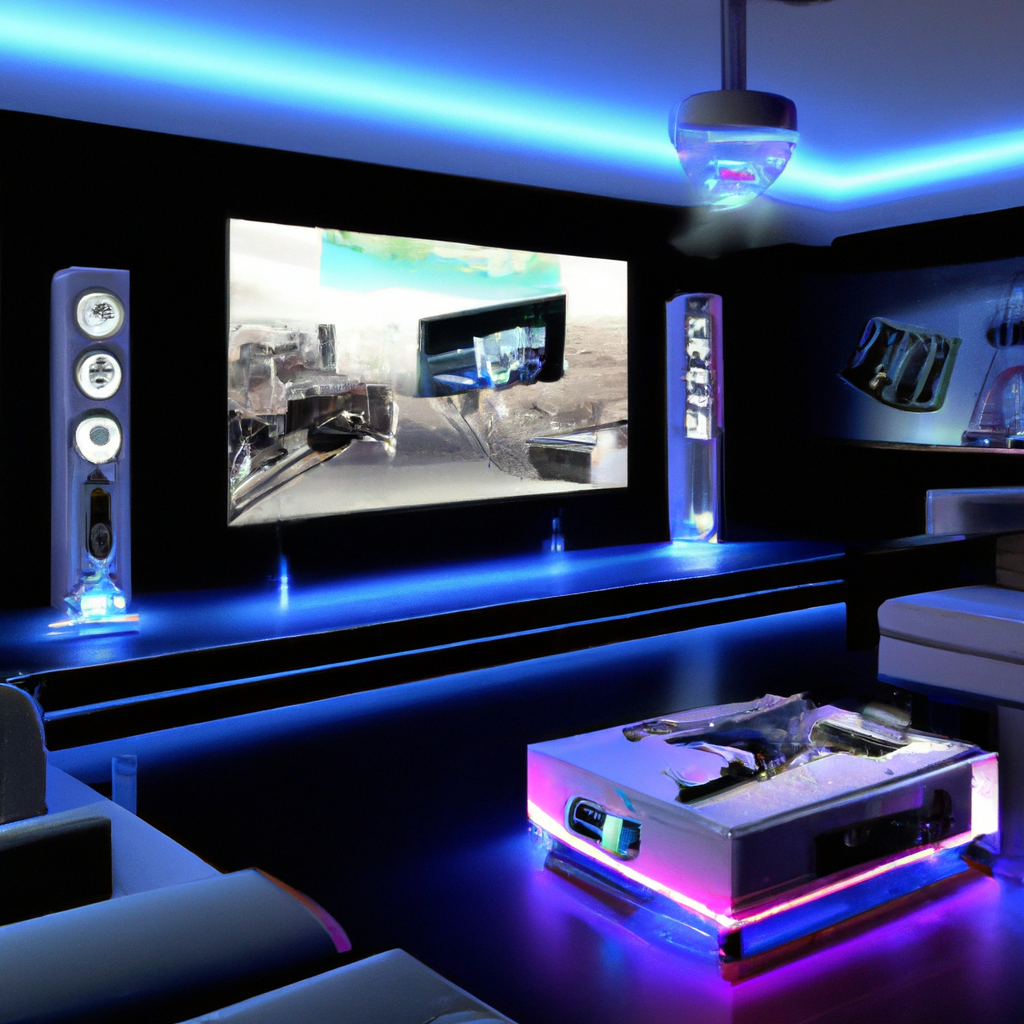Imagine a world where your favorite movies, TV shows, and music seamlessly follow you from room to room, creating an immersive entertainment experience throughout your home. It may sound like something out of a sci-fi movie, but with the rapid advancement of smart home technology, it has become a reality. In this article, you will discover how to create a seamless and immersive smart home entertainment ecosystem that will revolutionize the way you enjoy media in your own space. Say goodbye to interruptions and hello to a world of uninterrupted entertainment bliss.
Choosing the Right Smart Devices
Identifying Entertainment Needs
When it comes to creating a seamless and immersive smart home entertainment ecosystem, it’s essential to start by identifying your entertainment needs. Consider what types of entertainment you enjoy the most, such as movies, music, or gaming. This will help you narrow down the specific smart devices that will enhance your entertainment experience.
Researching and Comparing Devices
With a wide range of smart devices available in the market, it’s important to conduct thorough research and compare different options. Look for devices that have positive reviews, advanced features, and compatibility with your existing equipment. Take the time to read customer testimonials and expert reviews to ensure that the devices you choose are reliable and meet your requirements.
Compatibility and Integration
Compatibility and integration are key factors to consider when choosing smart devices for your entertainment ecosystem. Ensure that the devices you select are compatible with each other and can seamlessly integrate into your existing setup. Look for devices that support common protocols like Wi-Fi or Bluetooth to ensure smooth communication and control between devices.
Considering Budget Constraints
While it’s exciting to create a state-of-the-art entertainment ecosystem, it’s important to consider your budget constraints. Set a budget for your smart devices and prioritize your needs accordingly. Remember that expensive doesn’t always mean better, so research affordable options that still offer the features you desire. By considering your budget, you can create a well-rounded entertainment ecosystem without breaking the bank.
Creating a Centralized Control System
Home Assistant Hub Options
A centralized control system is essential for managing all your smart devices in one place. Consider investing in a home assistant hub, such as Amazon Echo or Google Home, which acts as a central control point for your ecosystem. These devices allow you to control various smart devices through voice commands, providing a convenient and hands-free experience.
Smart Speakers and Voice Control
Smart speakers are becoming increasingly popular for their ability to integrate with various smart devices and provide voice control functionality. With smart speakers, you can play music, adjust volumes, and even control your TV or lights with simple voice commands. Look for smart speakers that are compatible with your chosen home assistant hub for a seamless integration experience.
Remote Control and Mobile Apps
In addition to voice control, remote control and mobile apps can also provide a centralized control system for your smart devices. Many smart devices come with dedicated mobile apps that allow you to control and monitor them remotely. Ensure that the devices you choose have user-friendly mobile apps that offer all the necessary features for easy and convenient control.

Setting Up a Wireless Network
Choosing a Reliable Wi-Fi Router
A reliable Wi-Fi router is the backbone of your smart home entertainment ecosystem. When selecting a router, look for one that offers a strong and stable signal, high data transfer speeds, and advanced security features. Consider routers that support the latest Wi-Fi standards, such as Wi-Fi 6, for maximum performance and compatibility with your smart devices.
Ensuring Proper Placement and Coverage
To ensure optimal connectivity and coverage, it’s important to place your Wi-Fi router in a central location within your home. Avoid positioning it near obstructions or in areas with a lot of interference. If necessary, consider using Wi-Fi range extenders or mesh systems to expand coverage in larger homes or areas with weak signals.
Securing the Network
Securing your wireless network is crucial to protect your smart devices and personal information from potential security threats. Enable strong encryption, such as WPA2 or WPA3, on your Wi-Fi network to prevent unauthorized access. Additionally, regularly update your router’s firmware and use unique and strong passwords for both your Wi-Fi network and router administration.
Designing the Ideal Entertainment Room
Optimal TV Placement and Mounting
When designing your entertainment room, consider the optimal placement and mounting of your TV. The TV should be positioned at eye level and centered within the room for comfortable viewing. Mounting the TV on a wall can save space and provide a cleaner look. Ensure that the mounting bracket is sturdy and can support the weight of your TV.
Acoustic Considerations
To create an immersive entertainment experience, it’s important to consider acoustic factors in your entertainment room. Consider installing acoustic panels or soundproofing materials to minimize echo and outside noise. You can also position speakers strategically for optimal sound distribution and invest in a quality sound system to enhance the audio experience.
Smart Lighting and Ambience
Smart lighting can greatly enhance the ambiance of your entertainment room. Consider installing smart bulbs or light strips that can be controlled through your home assistant hub or mobile app. With smart lighting, you can create different lighting scenes to match the mood of your entertainment, whether it’s a cozy movie night or a party atmosphere.
Comfortable Furniture Arrangement
Don’t forget to pay attention to the furniture arrangement in your entertainment room. Ensure that seating is comfortable and positioned to provide the best viewing angles. Consider adding additional features like recliners or a sectional sofa for a more immersive and luxurious experience. Don’t overcrowd the room, and leave enough space for easy movement and interaction.

Building an Audio System
Choosing Between Soundbars, Speakers, or Home Theater Systems
When building an audio system for your entertainment room, you have several options to consider. Soundbars are a popular choice for their compact design and easy installation. They provide enhanced audio quality compared to built-in TV speakers. Alternatively, you can opt for separate speakers or a full home theater system for a more immersive audio experience.
Multi-room Audio Solutions
If you want to extend your audio experience beyond the entertainment room, consider investing in multi-room audio solutions. These systems allow you to play synchronized audio in different rooms, creating a seamless audio experience throughout your home. Look for audio systems that support wireless connectivity and can be controlled through your smart devices or home assistant hub.
Connecting and Syncing Devices
When connecting and syncing your audio devices, ensure that they are compatible and can communicate with each other. Wireless connectivity options like Bluetooth or Wi-Fi can simplify the setup process and allow for seamless integration. Follow the manufacturer’s instructions for proper device pairing and synchronization to ensure optimal performance and audio quality.
Connecting to Content Providers
Streaming Platforms and Subscription Services
One of the key components of a smart home entertainment ecosystem is access to various streaming platforms and subscription services. Consider subscribing to popular video streaming platforms like Netflix, Amazon Prime Video, or Disney+ to enjoy a wide range of movies and TV shows. Additionally, subscribe to music streaming services like Spotify or Apple Music to enhance your audio experience.
Choosing the Right Streaming Devices
To connect and access content from streaming platforms, you’ll need the right streaming devices. Popular options include streaming media players like Apple TV or Roku, smart TVs with built-in streaming capabilities, or even game consoles that support streaming apps. Choose devices that offer the features and supported platforms you desire for seamless content access.
Setting up User Profiles and Preferences
Setting up user profiles and preferences is essential for personalized and tailored entertainment experiences. Most streaming platforms allow you to create individual user profiles within a single account. This allows each family member to have their own personalized content recommendations and settings. Take advantage of these features to enhance your entertainment experience and ensure everyone’s preferences are accommodated.

Exploring Immersive Visual Experiences
Investigating Virtual Reality and Augmented Reality
Virtual Reality (VR) and Augmented Reality (AR) technologies are revolutionizing the way we experience entertainment. Consider exploring VR headsets or AR devices for a truly immersive visual experience. VR can transport you into virtual worlds, while AR can overlay digital elements onto your physical environment. Research different VR and AR options to find the one that suits your entertainment preferences.
Implementing Projectors and Screens
Consider implementing projectors and screens in your entertainment room to create a larger-than-life visual experience. Projectors can provide a cinema-like atmosphere, allowing you to enjoy movies and shows on a big screen. Choose a high-quality projector and screen that suits the size and layout of your room to ensure optimal image quality and immersion.
Enhancing Gaming Experiences
For gaming enthusiasts, enhancing the gaming experience is a priority. Invest in gaming consoles that offer advanced graphics and capabilities. Consider gaming monitors or TVs with high refresh rates and low input lag for smooth gameplay. Additionally, explore gaming accessories like VR gaming systems, gaming chairs, or surround sound systems to create a truly immersive gaming environment.
Integrating Smart Lighting and Automation
Smart Bulbs and Lighting Systems
Integrating smart lighting into your entertainment ecosystem can greatly enhance the overall ambiance and convenience. Smart bulbs and lighting systems allow you to control the color, brightness, and even the timing of your lights. Set up lighting scenes that automatically adjust based on your entertainment activities, such as dimming the lights when watching a movie or creating a vibrant atmosphere for parties.
Creating Lighting Scenes and Controls
A key aspect of smart lighting is the ability to create lighting scenes and controls. With your home assistant hub or mobile app, create different lighting scenes for various entertainment scenarios. For example, a “movie night” scene can dim the lights and turn on specific accent lights, while a “game time” scene can provide vibrant and dynamic lighting. Customize these scenes to match your preferences and needs.
Automating with Sensors and Timers
Consider automating your smart lighting system using sensors and timers. Motion sensors can detect when someone enters the room and automatically turn on the lights, providing a seamless and hands-free experience. Timers can be used to automatically adjust the lighting based on the time of day, ensuring that your entertainment room is always well-lit and ready for use. Experiment with different automation options to find what works best for you.

Enhancing Security and Privacy
Securing Smart Devices and Network
As smart devices become more prevalent in our homes, ensuring their security is crucial. Take the necessary steps to secure your smart devices and network. Change default passwords, enable two-factor authentication, and regularly update firmware to protect against potential vulnerabilities. Additionally, consider implementing network security measures, such as a firewall, to prevent unauthorized access to your smart home ecosystem.
Managing Privacy Settings
Privacy is another important aspect to consider when building a smart home entertainment ecosystem. Review the privacy settings of your smart devices and platforms to understand what information is being collected and how it is being used. Opt for devices and platforms that prioritize user privacy and provide granular control over data sharing and privacy settings.
Considering Camera Systems and Monitoring
Enhancing security in your smart home ecosystem can also involve implementing camera systems and monitoring solutions. Security cameras can be placed strategically to monitor your home and provide peace of mind. Look for cameras with features like motion detection, night vision, and remote access for real-time monitoring. Ensure that your camera systems are secure and encrypted to protect your privacy.
Troubleshooting and Maintenance
Handling Connectivity Issues
Despite careful planning, connectivity issues can still arise in a smart home entertainment ecosystem. If you experience connectivity problems, start by ensuring that all devices are connected to the same network and that your Wi-Fi signal is strong. Check for firmware updates for your devices and router, as these updates often include bug fixes and stability improvements. If the issue persists, consult the manufacturer’s troubleshooting guide or seek professional assistance.
Updating Firmware and Software
Regularly updating the firmware and software of your smart devices is essential for optimal performance and security. Firmware updates often include bug fixes, new features, and improved compatibility. Similarly, software updates for your home assistant hub, streaming devices, or mobile apps can enhance functionality and address any known issues. Set up automatic updates wherever possible to ensure you’re always running the latest versions.
Cleaning and Maintenance Tips
To maintain the longevity and performance of your smart devices, incorporate regular cleaning and maintenance into your routine. Follow the manufacturer’s instructions for cleaning and ensure that you use appropriate cleaning tools and solutions. Dust off speakers and screens regularly, clean remote controls, and check cables for any signs of wear or damage. By properly maintaining your devices, you can extend their lifespan and ensure they continue to perform at their best.
Creating a seamless and immersive smart home entertainment ecosystem requires careful consideration of your entertainment needs, thorough research of devices, and compatibility with your existing setup. By choosing the right smart devices, setting up a centralized control system, establishing a reliable wireless network, designing an ideal entertainment room, building an audio system, connecting to content providers, exploring immersive visual experiences, integrating smart lighting and automation, enhancing security and privacy, and knowing how to troubleshoot and maintain your system, you can enjoy the ultimate entertainment experience in your home.











